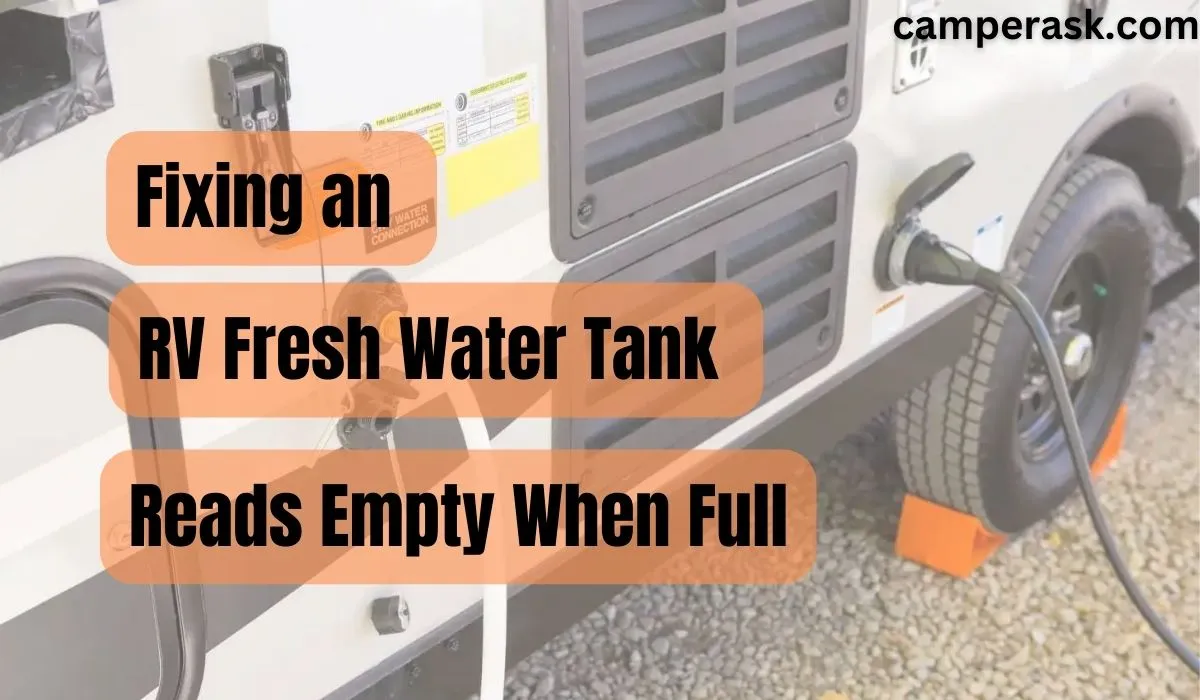RV fresh water tanks are an integral part of RV travel, providing a reliable source of clean, potable water for use on the road. However, it is not uncommon for RV owners to encounter issue like RV Fresh Water Tank Reads Empty When Full!
There are a number of potential reasons why your RV fresh water tank may be reading empty when it is actually full, ranging from faulty sensors to damaged plumbing.
By troubleshooting and addressing these issues, you can restore full functionality to your RV’s fresh water system and enjoy uninterrupted access to clean water while on the road.
READ ALSO: Reasons RV Grey Water Tank Reading Full When Empty

Causes and Steps by Step Guide of RV Fresh Water Tank Reads Empty When Full
There are several possible reasons why an RV fresh water tank may falsely read as full even when it is not:
- Faulty sensors: The sensors that measure the level of water in the tank may be damaged or malfunctioning, causing them to give inaccurate readings.
- Debris or sediment in the tank: If the tank has accumulated debris or sediment, it may cause the sensors to give false readings.
- Leaks or damaged plumbing: If there are leaks or damaged plumbing in the tank or water supply lines, it can cause the water level to drop even though the tank may still read as full.
- Incorrectly calibrated sensors: If the sensors are not properly calibrated, they may not accurately reflect the true water level in the tank.
- Wiring issues: Wiring issues with the sensor system or the control panel can also cause the tank to read as full when it is not.
By identifying and addressing the root cause of the problem, you can fix the issue and ensure that your RV fresh water tank is accurately reading the correct water level.
Here is a step-by-step guide on how to troubleshoot and fix an RV fresh water tank that is falsely reading as full:
Inspect the Sensors
Start by checking the sensors that gauge the tank’s water level. Ensure that they are spotless and devoid of any silt or debris.
The sensors must be changed if they are clearly damaged or are not operating correctly.
You can use AP Products 024-1000 Tank Check LP with Monitor Kit. This kit includes a new sensor and wiring that can be used to replace faulty or damaged sensors in an RV fresh water tank.
Look for Any Debris or Sediment
The next step is to check the tank for any debris or sediment that might be causing the sensors to give misleading readings if they seem to be working properly.
You must discover the tank’s access panel and carefully remove any dirt or silt that you find in order to accomplish this.
Try Hose Cleaner Foam Nozzle, Water Hose Nozzle, High Pressure Nozzles to completely remove Debris or Sediment from the RV tank.
Check for Damage or Leaks
Once the tank has been cleaned, check it and the water lines for any damage or leaks.
Before using the tank, any leaks that you discover must be fixed. This could entail patching any gaps or cracks or replacing any broken pipes.
Calibrate the Sensors
The sensors may need to be recalibrated if they are not precisely reflecting the actual water level in the tank.
For information on how to calibrate the sensors properly, refer to the manufacturer’s instructions. To ensure accurate readings, this can need changing the sensitivity or other settings.
Inspect the Wiring
If every other attempt at troubleshooting has failed, there might be a problem with the wiring of the sensor system or control panel.
For guidance on how to accurately identify and resolve any wiring problems, go to the manufacturer’s instructions.
This could entail inspecting for frayed wires or loose connections and making any necessary repairs.
These instructions should enable you to fix an RV fresh water tank that is incorrectly reporting as full and bring your RV’s water system back up and running.
Recommended Replacement Product Suggestion:
Barker Manufacturing Company 11917 26 Gal. Water Tank Kit
– Constructed with non-toxic and food grade hydrocarbon technology.
– Hose barbed architecture inlets.
– 26 gallon with rust and corrosion resistance.
RV Fresh Water Tank Reads Empty When Full – (FAQs)
What is the difference between an RV’s fresh, grey, and black water tanks?
Fresh water tanks store clean, potable water for drinking and other household uses.
Grey water tanks store water that has been used for showering, washing dishes, and other household uses.
Black water tanks store sewage and wastewater from the toilet.
Can I use my RV’s grey water tank to store additional fresh water?
It is not recommended to store fresh water in the grey water tank, as it is designed to store water that has already been used for household purposes.
Using the grey water tank for fresh water may cause plumbing issues or contamination of the water.
Can I use regular tap water to fill my RV’s fresh water tank?
Yes, you can use regular tap water to fill your RV’s fresh water tank. It is important to ensure that the water is clean and potable, as it will be used for drinking and other household purposes.
Can I use my RV’s water tanks while the RV is in motion?
It is generally not recommended to use the water tanks while the RV is in motion, as it can cause the water to slosh around and potentially damage the plumbing or sensors.
It is best to wait until the RV is parked and stable before using the water tanks.

